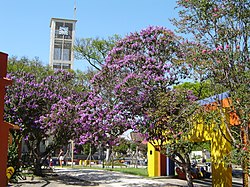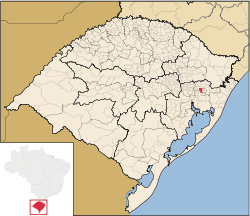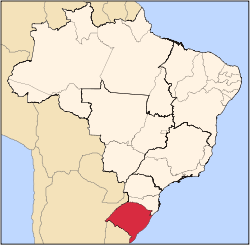This article needs additional citations for verification .(September 2025) |
Sapiranga | |
|---|---|
 | |
 Location in Rio Grande do Sul, Brazil | |
| Country | Brazil |
| Region | South |
| State | Rio Grande do Sul |
| Founded | 1955 |
| Government | |
| • Mayor | Corinha Molling (PP) |
| Area | |
• Total | 137.519 km2 (53.096 sq mi) |
| Population (2020 [1] ) | |
• Total | 75.613 |
| • Density | 538.0/km2 (1,393/sq mi) |
| Time zone | UTC−3 (BRT) |
| Website | Prefeitura de Sapiranga |
Sapiranga is a city in Brazil in the state of Rio Grande do Sul with a population of roughly 80,000 inhabitants. It is located in an industrial area called "Vale dos Sinos", by the Rio dos Sinos (River of the Bells). The town's economy relies heavily on the shoe industry. Other industries are present, but mostly linked to the shoe manufacturing process, such as metallurgic plants in which machinery is built to later be employed in the production of shoes.
Contents
Sapiranga is 59 km (37 mi) away from Porto Alegre. The city's area is 137.5 km2 (53 sq mi).
Sapiranga is known as the "City of the Roses". Sapiranga's Festival of Roses originated with simple competitions to see who had the best gardens or bouquets of roses. Today, it has grown into a large festival with music, dancing, and roses. It takes place each November in the Immigrant Park.




